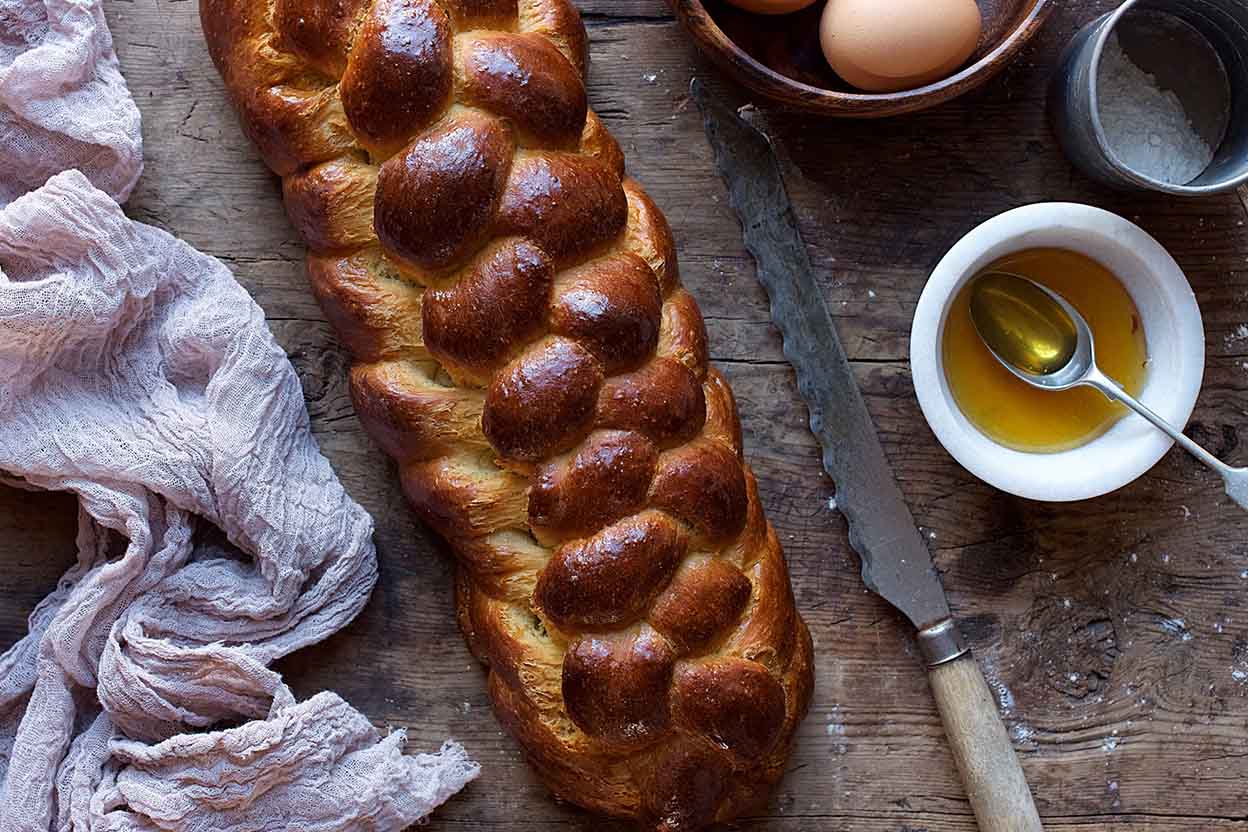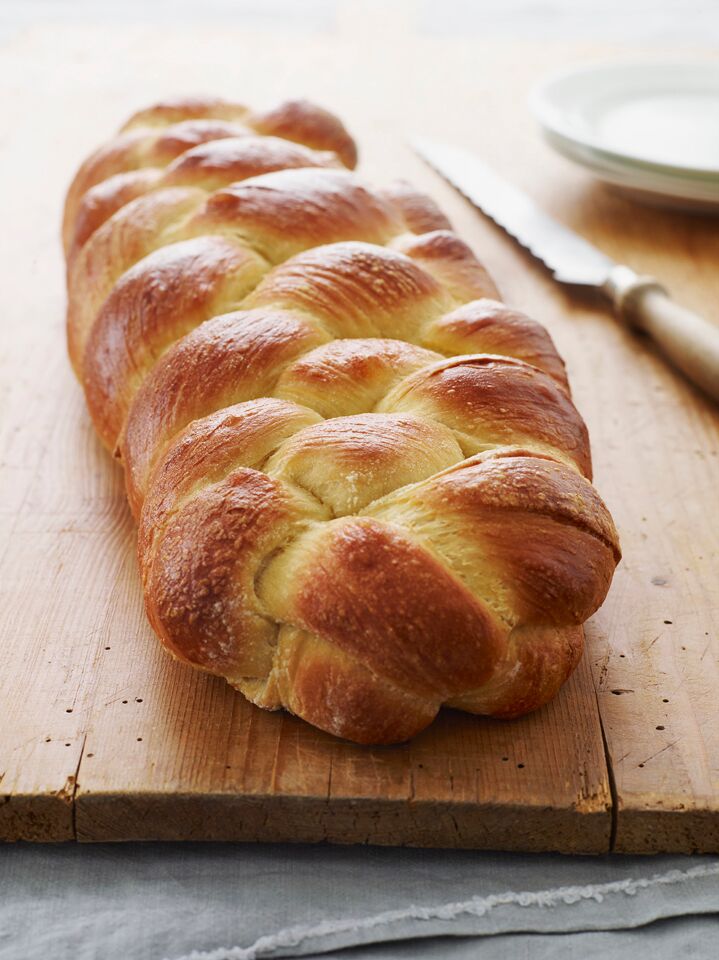The word challah originally meant only the small portion of dough that was put in the oven when baking bread as a reminder of the destruction of the Temple in Jerusalem. It has evolved into the twisted, sweet, almost brioche-like bread that was brought to America by immigrants from Central and Eastern Europe. Although straight loaves of braided challah are eaten throughout the year, round challahs, often studded with raisins, are served for Rosh Hashana, and also for Yom Kippur and Sukkot, the holidays celebrating the New Year and the fall harvest. Throughout the years, I have picked up tips from challah bakers throughout this country and in Europe and Israel. For example: Several risings make a better loaf, and if you want an especially brioche-like texture, let the dough rise slowly in the refrigerator for one of the three risings. The secret to a glossy loaf is to brush with an egg wash twice, once just after braiding and then again just before baking.

Classic Challah

This deep-gold, light-textured bread is traditionally served on the Jewish Sabbath and other holidays. The dough is wonderfully smooth and supple, making it an ideal candidate for braiding. The simplest way to go is a three-strand braid; but feel free to try the slightly more complex four-strand braid, or even a six-strand braid, which makes a striking presentation. The inspiration for this recipe comes from Lora Brody, cookbook author, photographer, and long-time King Arthur friend. This recipe has been amended as of 3/16/21 — please see the details in “tips,” below.
Prep: 20min
Total: 3h50min
Yield: 16
Serving Size: 58g
Nutrition Facts: servingSize 58g, calories 180 calories, Carbohydrate 28g, Cholesterol 35mg, Fiber 1g, Protein 5g, Sodium 230mg, Sugar 4g, Fat 6g, Saturated Fat .5g, Trans Fat 0g
Ingredients:
- 4 to 4 1/4 cups (480g to 510g) King Arthur Unbleached All-Purpose Flour
- 3/4 cup (170g) water lukewarm
- 6 tablespoons (74g) vegetable oil
- 3 tablespoons (63g) honey
- 2 large eggs
- 1 large egg yolk (white reserved for the topping)
- 1 1/2 teaspoons (9g) salt
- 4 teaspoons (12g) instant yeast
- 1 large egg white (reserved from above) beaten with 1 tablespoon cold water
- poppy seeds or sesame seeds for sprinkling; optional
Instruction:
To make the dough: Weigh 480g of flour; or measure 4 cups by gently spooning it into a cup, then sweeping off any excess. , Combine the flour with the rest of the dough ingredients. Mix and knead them by hand, mixer, or bread machine, until you have a soft, smooth dough. If the dough is very sticky, add an additional 1/4 cup (30g) of flour., Allow the dough to rise in a plastic wrap-covered bowl for about 2 hours, or until it’s puffy; it won’t necessarily double in bulk., Gently deflate the dough, and transfer it to a lightly greased work surface., Divide the dough into pieces, the number depending on what kind of braid you want to make. You may braid the challah the traditional way, into a three-strand braid; for helpful tips watch our video, How to braid a three-strand loaf. For a fancier presentation, make a six-strand braid; watch our video, How to braid a six-strand loaf, to see how it’s done. To make a four-strand braid, see shaping instructions in our blog post about making four-strand braided challah. , Once you’ve decided which braid you’re doing, divide the dough into the appropriate number of pieces. Roll each piece into a rope about 20″ long. If the dough starts to shrink back as you roll, cover it and let it rest for about 10 minutes, then resume rolling. The short rest gives the gluten a chance to relax., Braid the loaf. Remember, for three- or six-strand braids, watch the videos linked above. For a four-strand braid, see the step-by-step photos of how to make a four-strand braid., Gently pick up the braided loaf, and place it on a lightly greased or parchment-lined baking sheet., Cover the loaf with lightly greased plastic wrap and let it rise at room temperature until it’s very puffy, 60 to 90 minutes. Toward the end of the rising time, place a rack in the upper third of your oven and preheat the oven to 375°F., To make the topping: Whisk together the reserved egg white and water. Brush the mixture over the risen loaf. Sprinkle generously with poppy seeds or sesame seeds, if desired., Bake the challah on the oven’s upper rack for 25 to 30 minutes, or until it’s a deep golden brown and a digital thermometer inserted into the center reads 190°F., Remove the challah from the oven and transfer it to a rack to cool., Storage information: Store any leftover challah, well wrapped, at room temperature for several days; freeze for longer storage. While challah does tend to dry out after a day or so, it’s always good toasted, or made into grilled sandwiches or French toast.
Challah

With its rich, slightly sweet flavor, shiny golden crust, and pillowy interior, challah isn’t just for the Jewish holidays — it appeals to everyone, any time!
Yield: One 16-inch [40 cm] loaf
Serving Size: 1 slice
Nutrition Facts: servingSize 1 slice, calories 206, Fat 7 g, Carbohydrate 32 g, Protein 5 g, Saturated Fat 1 g, unSaturated Fat , Sugar 7 g, Fiber 1 g, Sodium 126 mg, Cholesterol 35 mg
Ingredients:
- 4¼ cups all-purpose flour, spooned into measuring cup and leveled-off, plus more for dusting
- 1 tablespoon instant/rapid-rise yeast (see Note)
- 2 teaspoons salt
- ¾ cup lukewarm water
- ¼ cup + 2 tablespoons vegetable oil
- ¼ cup + 2 tablespoons honey
- 3 eggs, at room temperature
- 1 egg yolk, at room temperature
Instruction:
- In a stand mixer fitted with the dough hook, combine the flour, yeast, and salt. Mix on low speed for 30 seconds to combine. In a separate bowl, combine the lukewarm water, oil, honey, 2 of the eggs, and the egg yolk. Add to the dry ingredients and knead on medium-low speed until you have a sticky dough that clings to the bottom of the bowl, 5 to 7 minutes. The dough may seem too wet but have faith—it’s supposed to be.
- Dust your hands generously with flour, then scrape the sticky, elastic dough out onto a lightly floured work surface. Dust the top of the dough lightly with flour and knead briefly into a soft, smooth ball. Lightly grease a large bowl with oil or nonstick cooking spray. Place the dough in the bowl, flip it over once so the top is lightly oiled, and then cover the bowl with plastic wrap. Allow the dough to rise in a warm, draft-free spot until it’s puffy and doubled in size, 2 to 3 hours.
- Invert the dough onto a lightly floured work surface and dust with flour. It will deflate. Cut the dough into four even 9-oz pieces, and then stretch and roll each piece into a rope about 20-inches long. Lay the ropes parallel to one another (vertically). Pinch them tightly together at the top, and then fan them out. If the ropes shrink a bit, just work them back into their original length.
- Begin by taking the strand farthest to the right and weave it toward the left through the other strands using this pattern: over, under, over. Take the strand furthest to the right and repeat the weaving pattern again: over, under, over. Repeat this pattern, always starting with the strand farthest to the right, until the whole loaf is braided. Tuck the ends under to give the loaf a finished look.
- Carefully transfer the braided loaf to a parchment-lined 13 x 18-inch baking sheet. Cover the loaf loosely with plastic wrap and let it rise in a warm, draft-free spot until about 1.5 times the size, 1 to 2 hours. Toward the end of the rising time, preheat the oven to 350°F and set an oven rack in the middle position. (Note that the loaf will continue to rise significantly in the oven.)
- In a small bowl, beat the remaining egg and brush the beaten egg generously over the risen dough. (Note: If you like, sprinkle poppy or sesame seeds onto the challah before putting it in the oven.) Place the baking sheet atop another baking sheet; this will prevent the bottom crust from browning too much. Bake for 25 to 35 minutes, until the crust is a rich brown color and the internal temperature is between 190°F and 200°F on an instant-read thermometer. Remove the bread from the oven and place it on a rack to cool. Challah is best enjoyed fresh, but leftovers will keep for a few days in a sealed plastic bag.
- Note: Active dry yeast may be used instead of instant/rapid-rise yeast, however, the dough will take longer to rise.
- Note: When baking yeast breads, rising times are only a guide; the temperature in your kitchen, the humidity level outdoors, and how you knead the dough will all affect the rising time.
- Make-Ahead Instructions: Prepare the loaf up to the point where it’s braided and on the pan. Cover it with greased plastic wrap, and place it in the refrigerator overnight. The next day, remove the braided dough from the refrigerator and set it on the countertop (keep it covered). Let it come to room temperature and rise for about 1 hour before baking as directed.
- Freezer-Friendly Instructions: Challah can be baked, cooled, tightly wrapped, and frozen for up to 3 months. Allow it to thaw at room temperature for at least 3 hours before serving.
Claire Saffitz Makes Perfect Challah and Babka | Try This at Home | NYT Cooking
FAQ
What makes challah different from bread?
What flour is best for challah?
Why do Jews bake challah?
What makes a challah a challah?
